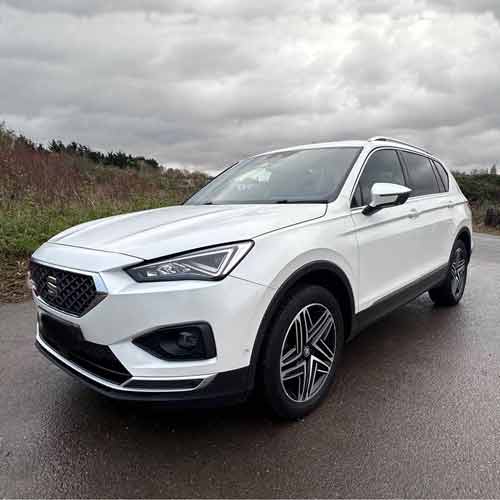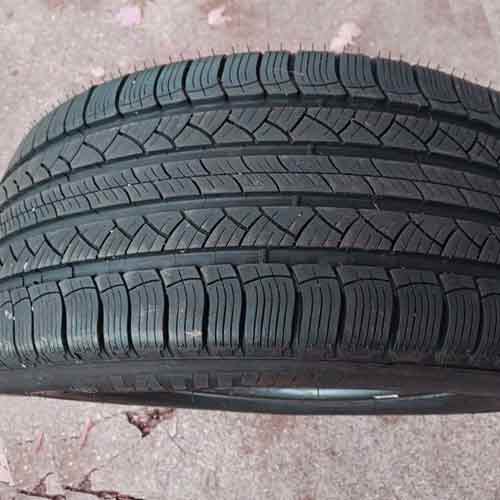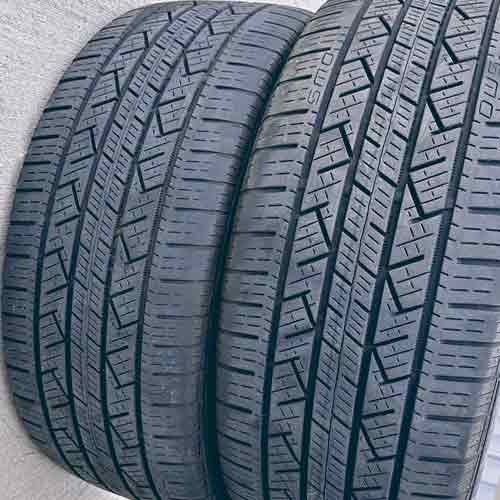When it comes to Crossover Touring All-Season tires, both the Michelin Latitude Tour HP and the Continental CrossContact LX25 are great options, designed to cater to the diverse needs of modern SUVs. But which out of them is a better pick for you? Well, let’s find out.

Table of Contents
Key Points
So overall, the Michelin Tour HP takes the lead in:
- Superior linear and lateral dry grip.
- Faster average braking distance.
- Quicker steering response and handling.
- Enhanced directional grip due to elongated ribs and dense central tread.
Detailed Discussion on Tour HP.
Whereas CrossContact LX25 excels in:
- Better handling in snow and ice with open tread design and flexible biters.
- Superior wet performance with dense siping and softer compound.
- Enhanced ride comfort and reduced noise levels.
- Longer tread life and improved resistance to hydroplaning.
Info on Sizes
The Michelin Latitude Tour HP comes in 16 to 22 inches rims, and they have the following specs.
- Speed ratings: H, V, W, and Y.
- Load ratings: SL and XL.
- Tread depth range: 9 to 10/32″.
- Weight range: 27 to 43 lbs.
- Treadwear warranty: 55k miles for H and V rated sizes, and 45k for W, and Y speed rated ones.
- UTQG rating: 440 A B.
- Internally, the tire comes with a single-ply polyester casing, flanked by two steel belts and a nylon cap ply.
On the other side, the Continental CrossContact LX25 comes in 16 to 22 inches wheels, with following specs.
- Speed ratings: T, H and V.
- Load ratings: SL and XL.
- Tread depth range: 12/32″ on all.
- Weight range: 25 to 42 lbs.
- Treadwear warranty: 70k for H and T rated sizes, and 65k for V speed rated ones.
- UTQG rating: 740 A A.
- Internally, the tire comes with a 2-ply polyester casing, with two steel belts, spirally wound polyamide cap ply, and an absorption layer for comfort performance (which Continental likes to call Comfort Ride Technology).
Performance on Dry Roads
Let’s explore the crucial aspects of dry tire performance separately: assessing the linear and lateral grip and the steering response.
Directional Grip
The primary factor affecting a tire’s “straight-line” or directional traction is its central region.
But why does the central tread footprint hold such importance?
Well, this area endures the bulk of concentrated weight (of vehicle and tire itself), particularly when the tire is in linear motion. In fact, this is the reason tires often have continuous ribs or denser lugs at the center compared to their shoulders.
Now, here the Latitude Tour HP takes the upper hand, demonstrating a feet shorter average braking distance, (which is how this grip gets measured).

This Michelin’s tire basically is designed with elongated ribs and fewer voids, enhancing road contact and thereby increasing friction and grip.
Conversely, the Continental CrossContact LX25 features a more voided central rib, which slightly diminishes its performance compared to the Michelin, despite the marginal difference of less than a foot.
Lateral Traction
When it comes to dry handling, you’ve really got to focus on how well the car grips to the side (lateral traction) and how quickly it responds to steering.
Now, talking about grip first, both these tires are pretty good here. I mean both of them are pretty much neck and neck, giving you similar lateral g forces (on tests, on average).
This is mainly because both boys offers a lot of biters.
The Michelin Latitude Tour HP has some very effective in-groove notches/ deep cuts giving the tire bite. I am talking about those longitudinal voids in its shoulders and multi-directional ones on the central ribs.

Whereas the CrossContact LX25 offers the same. As you can see (in its tread image), it offers similar multi-directional in-block notches on the ribs (also called block columns) between central most and shoulder ribs.
Though, when we talk about overall handling, Michelin’s the one beating the clock, being over a 0.5 seconds quicker in handling lap tests, mostly all thanks to its stellar steering feel.
Steering Dynamics
Before we jump in, it’s crucial to grasp the three key stages of cornering:
- Entry: This is the beginning of the turn, where braking comes into play.
- Mid-Corner: At this point, the car is halfway through the turn, and steering response becomes critical.
- Exit: Finally, as you straighten the car out, the tire’s ability to re-center without slipping is what matters most.
The Michelin Latitude Tour HP shines in all these areas. As mentioned earlier, it offers slightly faster braking (due to its superior directional grip).
Moreover, its solid steering feedback during the mid-corner and exit phases ensures stable tire performance without any over or understeering issues.
Conversely, the Continental CrossContact LX25 isn’t terrible, but its steering response is slightly slower compared to the Latitude.
Why is this? Well, the answer lies in its design.
The tire basically lacks with its Comfort Ride Technology, which incorporates a cushioning layer above the nylon cap plies, leading to a softer tire structure.
This design makes the tire’s lugs more flexible, which, while comfortable, can slightly affect the tire’s balance and lead to a bit of understeering.
Ride Comfort
Driving comfort hinges on two things: the noise level of the tire tread and the tire’s proficiency at cushioning road irregularities. Let’s dissect and understand these components.
Noise Reduction
When assessing tire noise, it’s essential to understand that it primarily comes from air particles hitting the tread walls. In other words, as tire rolls, air gets compressed in and out of the tire hitting tread and features on it, generating unwanted sounds.
That’s why out of both tires, the Continental CrossContact LX25 comes out quieter (on decibel scale), with its packed up shoulder blocks, and adjacent (continuous-running ribs), blocking lateral voids.
This limits the air entry in the first place, handling noise at its source.
Moreover, the tire also features a relatively more absorbent rubber composition and structure, keeping in-groove resonance (or echoing of noise) to a minimum as well.
Impact Comfort
The smoothness of a ride largely hinges on a tire’s capacity to absorb road irregularities effectively. And here the Continental’s tire once again stands out as a more preferable option.
This superior comfort is due to the LX25’s distinctive design, featuring an extra layer atop its nylon cap plies, specifically engineered to soften the impact of road bumps, (aptly named the Comfort Ride Technology).
Additionally, its polyester casing features a more flexible makeup, further enhancing the tire’s ability to adapt and smooth out the ride.
And yes one more thing, the tread on CrossContact is also infused with +Silane additives. While primarily aimed at increasing fuel efficiency, these additives also play a significant role in diminishing road vibrations, contributing to a more serene driving experience.
Side Note: You may want to check out my detailed post on noise and comfort from all-season tires.
Wet Performance
Wet performance requires a lot of engineering, mostly because of the fact that water can not be squeezed. Meaning, it has to go somewhere otherwise it would cause tire to float or “hydroplane”.
Come in the sipes and the grooves.
Grooves play a primary role in shifting most of the water, but sipes enhance this by a significant margin.
At a glance, these sipes might just look like small cuts, but they’re crucial for improving grip, functioning at a microscopic level, as they expand to expel air and contract to create a suction effect, pulling in water particles (left out by the grooves).
Now, taking this in to account reveals two essential features of an effective wet tire:
- First, it must have plenty of sipes.
- Second, it must use these sipes or maintain tread flexibility.
This understanding clarifies why the Michelin Latitude Tour HP falls a bit short in wet conditions (in my tests).
Despite having plenty of curved interlocking sipes, its stiffer compound limits their flexibility, diminishing its wet handling performance (for the most part).
On the other hand, the Continental CrossContact LX25 fares better, featuring denser siping along with a softer compound, ensuring the sipes stay flexible, even during tight maneuvers.
Additionally, this tire has more “voids”, offering improved resistance to hydroplaning. Its slightly balder tread leads to faster water dispersal, enhancing traction by reducing the initial reliance on sipes.
Tread Life
To really shine in tread life, a tire needs a mix of robust construction and smart design. This often involves using tougher rubber to withstand wear while ensuring a steady grip under different conditions.
Now out of both tires here, the CrossContact LX25 is better here, offering 60 to 70k miles on average (throughout its tread life).
This is primarily due to its comparatively lighter structure, despite having more layers in its build.
This reduced weight translates to less pressure on the tire’s lugs when they hit the road, which in turn helps prolong the tire’s tread life.
Conversely, the Michelin Latitude Tour HP, tailored for “high-performance” SUVs although provide superior grip, this benefit is offset by increased rolling resistance, which not only shortens the tire’s lifespan but also affects fuel efficiency.
For those curious about Michelin’s range, it’s worth considering the standard Michelin Latitude Tour, not the “HP” model. Though they look similar, the standard version boasts a longer tread life with a 65,000-mile warranty, while the HP variant’s warranty ranges between 45,000 to 55,000 miles, depending on the speed ratings.
Winter Traction
When evaluating how well tires perform in winter conditions, three important aspects are considered:
- How well the tire handles.
- How well it maintains direction on slippery surfaces.
- And how well it accelerates, especially on snow and ice.
Now, here, the Michelin Latitude Tour HP, with a ton of biters and siping although offers appreciable performance, it still lacks to Continental’s tire due to its stiffer rubber composition.
Basically, its biters tend to stiffen up (further) with colder temperatures, losing traction.
On the other hand, the Continental CrossContact LX25 is designed with features that make it more suitable for harsh winter conditions.
It’s a bit narrower (section width), and has an open tread design, which is effective at moving snow out of the way, helping the car move better in snowy conditions.
Moreover, the shape of its tread elements, or “biters”, is especially good at holding onto snow, which improves traction because snow sticks better to itself than to rubber.
Summing Up
Overall, while both tires have their strengths, the CrossContact LX25 stands out for its versatile performance across various conditions, making it a more reliable choice for SUV owners.
Though the Michelin Latitude Tour HP does offer superior dry performance with its elongated ribs and dense central tread, providing excellent directional grip and braking.
But yes, it falls short in wet and winter conditions due to its stiffer composition.
And this stiffer rubber of this tire also puts it behind in terms of road comfort performance as well.